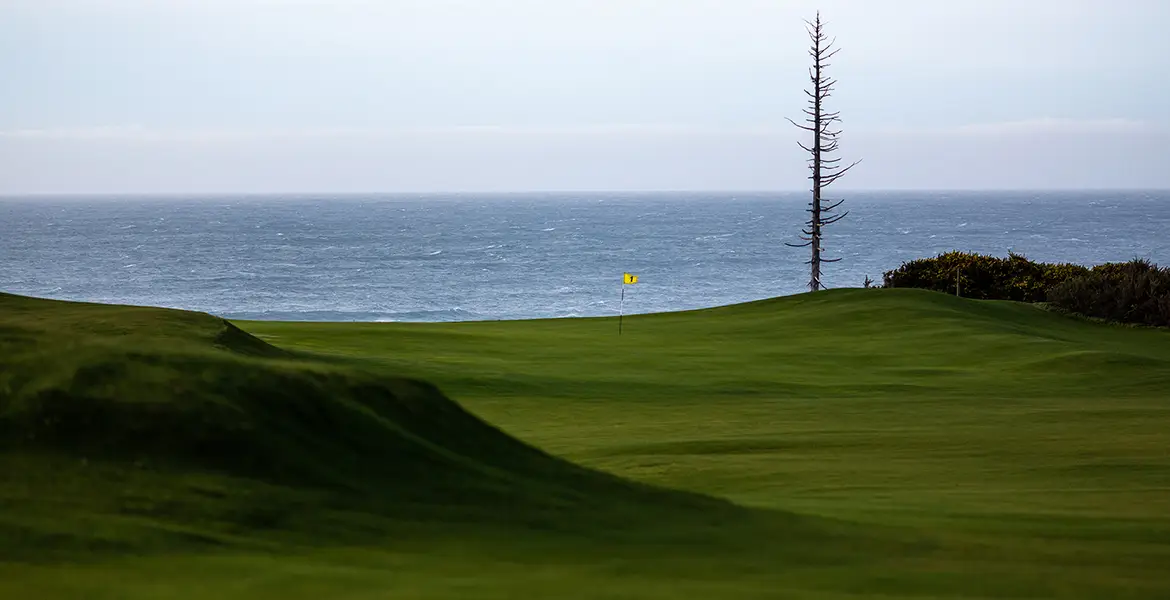History and mystique distinguish the most natural links in the world
Dornoch is a supernatural place. It was here in the 18th century that Janet Horne, “the last witch in Scotland,” was summarily executed. Ever since, Royal Dornoch has cast a spell over golfers.
Situated in the far north of Scotland, Dornoch is 600 miles from London and, at 58 degrees north, a similar latitude as Hudson Bay in Canada. Remote it may be, but this didn’t deter Messrs Vardon, Braid, and Taylor from traveling there in the early years of the 20th century, nor the great Joyce Wethered, who made regular trips from the south of England. In more recent times, Jack Nicklaus, Tom Watson, Greg Norman, and Ben Crenshaw have all embarked on this irresistible pilgrimage.

So what is it that makes Royal Dornoch so alluring?
First, there is the sublime setting. Bordered by the Dornoch Firth and, for its entire length, by a beautiful sweep of pristine white sand, mountains and hills fill the horizon and create the illusion that golf is being performed on a giant stage. Much of the links is blanketed in gorse, which, when it flowers in late spring, turns the golf canvas from green to gold, a glorious sight.
Then there is Dornoch’s rich history. It is the third oldest links in the world, with records suggesting the game has been played here since 1616. The first formal club was established in 1877 when a rudimentary 9-hole course existed. In 1886, Old Tom Morris was invited to lay out “nine proper golf holes” and, three years later, a full 18. Old Tom brilliantly used the wealth of natural features and, notwithstanding subsequent revisions, it is he who deserves the acclaim for discovering the links’s infinite possibilities.
Another famous local figure was Donald Ross. Born in Dornoch in 1872, as a young man he moved to St. Andrews to become one of Old Tom’s assistants. In 1895, Ross returned to Dornoch to serve as head greenkeeper; yet in less than four years he was off again, this time to conquer America. Pinehurst No. 2 is often cited as Ross’s architectural masterpiece, and his memories of Dornoch were its prime inspiration.

A third compelling, never mind captivating, attraction is the quality and character of the golf itself. Royal Dornoch is widely regarded as the most natural links in the world. Renowned for its large, ingeniously contoured greens, many of which sit on natural plateaus, the course flows seamlessly from tee to green to tee. On first impression, it appears to have a traditional out-and-back layout, but, in fact, the routing is more S-shaped and, unusually, occupies two distinct levels. In broad terms, you head out along, and occasionally in the lee of, an upper level and return on a lower level adjacent to the shore.
The visually dramatic run of holes between the 3rd and 6th is often hailed as one of golf’s finest sequences, and yet it is the back nine that includes a collection that truly identifies Dornoch. Between the 9th and 15th, you rarely move far from the shoreline as you weave in and out of the dunes, the direction and strength of the wind invariably determining your strategy. Each hole is a classic, although the best known is probably “Foxy,” the bunkerless, extraordinarily double-doglegging, par-four 14th.
The uphill 16th is perhaps the only pedestrian hole at Dornoch, but then comes the wonderfully cavalier down-and-up 17th, with its mischievous bunker set into a heathery ridge 50 yards short of a wildly undulating green. Finally, a formidable two-shotter leads you back to the clubhouse, where yet more enchantment warmly awaits.
Thank you for supporting our journalism. If you prefer to read in print, you can also find this article in the Summer 2024 issue of LINKS Magazine. Click here for more information.






